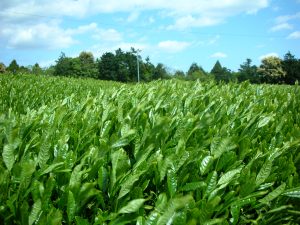
Have you heard about Yabukita before? It’s the name of the most popular Japanese tea cultivar.
This post is the first in a series about the cultivars found in Japan.
What is a cultivar?
The tea plant, Camellia sinensis, comes in two main varieties:
- Camellia sinensis var. sinensis (mainly found in China and Japan)
- Camellia sinensis var. assamica (cultivated mostly in India and Sri Lanka)
However, within a same variety you can find tea plants with many different traits. This is where cultivars come into play.
Cultivar means “cultivated variety”. In other words, it’s a tea plant that has been selected by farmers to cultivate.
For more information about cultivars, please read this excellent post by Tea Geek.
Japanese cultivars
Japanese cultivars are selected by farmers in two ways: by their intended type of tea and by the region’s climate.
Some cultivars are better suited for sencha (in terms of taste and aroma), others for gyokuro and tencha (because they fare better in shaded conditions), and for kamairicha (for the optimal roasted aroma, characteristic of this type of tea). Lately, there are also cultivars meant for Japanese black tea.
In regions with warm weather, there isn’t much risk of having the tea plant being damaged by frost. In this case, to have shincha before anyone else there are cultivars that can be harvested earlier: waseshu (早生種).
In contrast, some regions are very cold. A good way to prevent frost damage is to have cultivars that can be harvested later on, when the weather gets warmer: banseishu (晩生種).
The cultivars that can be harvested at the normal time (such as Yabukita), fall under the category of chuuseishu (中生種).
Another option is to have different types of these cultivars in the same plantation. That way, if you have a large area of tea fields, there’s no need to harvest them all at the same time.
There are more than 50 cultivars in Japan. I have compiled the list of Japanese cultivars for you to take a look at.





September 29, 2013
I rather like the teas I’ve had from the zairai cultivar. Quite sumptuous.
September 29, 2013
Hi Geoff
Zairai, meaning “native”, refers to very old tea plants, many of which have been propagated by seeds. Hence, they are not all exactly alike, unlike cultivars that are clones.
I don’t believe it classifies as a true cultivar because of that reason.
Anyway, these zairai tea plants (or trees) do offer a great taste : )
April 19, 2023
Hi, I’m from Malaysia and wud like to plant a tea tree at my home. Where can I get a seedling or seeds to grow them ? Thanks !
April 20, 2023
Hi HL
Since I don’t live in Malaysia I wouldn’t know. Maybe you can ask a company that has a tea plantation in your country.
October 10, 2023
Is it necessary to fertilize a blooming tea plant?
October 10, 2023
Hi Susan
For commercial purposes, there’s a regular fertilizing schedule. It depends on your particular soil.
It’s outside my area of expertise. I review teas, but I don’t cultivate tea.